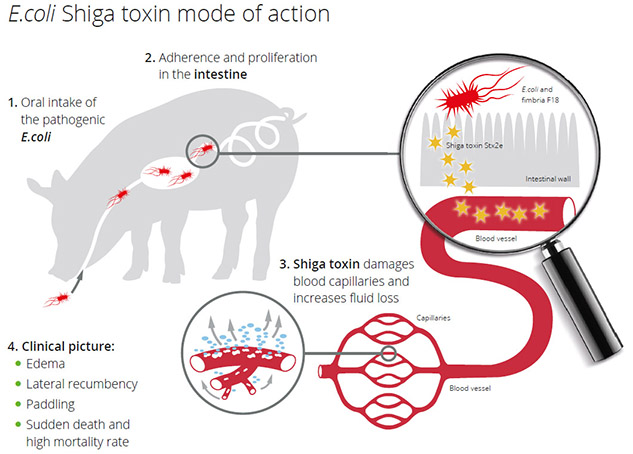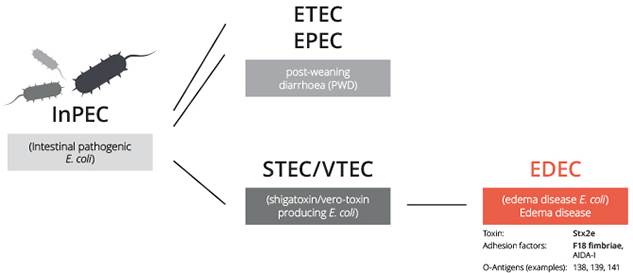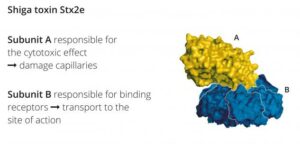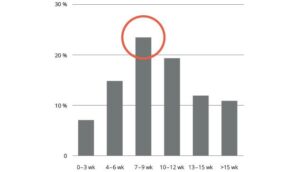Edema (Oedema) Disease

Pathogenesis of Edema (Oedema) Disease (ED)
The causative agent of ED is Shigatoxin-2e. It´s encoded and produced by a specific virotype Escherichia coli and occurs worldwide in diseased pig herds as well as in healthy herds. The primary habitat E. coli in pigs is the gastrointestinal tract. Outside the intestine E. coli are found in fecal-contaminated feed or water, water from water pipes contaminated by biofilm (Wöchtl B. et al, Tierärztl). Umschau 72, 2017), soil, and the environment of the pig barn. The infection happens via the oral route. When ingested in sufficient numbers, E. coli causing ED colonize and then proliferate rapidly to attain massive numbers. Colonization develops over 3-6 days and requires attachment of fimbrial adhesins to complementary receptors on the small intestinal epithelium or in the mucus coating in the distal jejunum and ileum. Stx2e is absorbed into the circulation and causes vascular damage in target organs.
The degenerative angiopathy of small arteries and arterioles results in an increase in vascular permeability. Due to osmosis, fluid leaves the vascular system and diffundates into various tissues, causing lesions that can be seen macroscopically as edema.
Gelatinous edema appears in the submucosa of the gastric cardia and occasionally in the fundus, in the mesocolon, in the small intestinal mesentery and gallbladder bed. The mesenteric and colic lymph nodes may be swollen, edematous and congested. Edematous swelling of eyelids, forehead, larynx and brain can be observed.
(Source: Diseases of Swine, Tenth Edition, Edited by J.J. Zimmerman et al., John Wiley & Sons, Inc. Published 2012)
Clinical signs of Edema (Oedema) Disease (ED)
ED mostly occurs in recently weaned pigs, although cases may be observed in later production stages as well. The disease may be sporadic and may affect only individual animals, but occasionally an entire batch of pigs is affected.
The subacute/ acute outbreak often is recognized as sudden death without previous signs of sickness. Pigs dead of ED are mostly in good condition. Some affected pigs become anorexic, develop swelling of the eyelids and forehead. As a result of the laryngeal edema some pigs emit a peculiar squeal. Due to the edema in the brain pigs show convulsions, ataxia and lateral recumbency with paddling of limbs. Few pigs survive the acute disease, but those that do remain runts (i.e. show stunted growth).
The course of the disease can also be prolonged. Clinical signs then reoccur in the same batch of pigs, especially after further change of feed, removal of zinc oxide (ZnO) or antimicrobials from the feed or another stress factor.
Subclinical ED may also occur, where pigs are clinically normal but develop microvascular lesions and may have a decreased growth rate. These herds may show inhomogeneous groups of pigs in the different production stages.
<!– Learn more –>
Chronic ED occurs in a low proportion of pigs recovering from acute disease or in herds where chimeric E.coli, which produce the heat labile (LT) and heat stabile (ST) toxins that cause post-weaning diarrhea (PWD) but also produce Shigatoxin-2e, are detected. For periods varying from days to several weeks after intestinal infection, growth stops and sick pigs often show unilateral nervous disturbances such as circling movements, twisting of the head, or atrophy of limb muscles with progressive weakness. In these cases subcutaneous edema is rare.
(Source: Diseases of Swine, Tenth Edition, Edited by J.J. Zimmerman et al., John Wiley & Sons, Inc. Published 2012)



